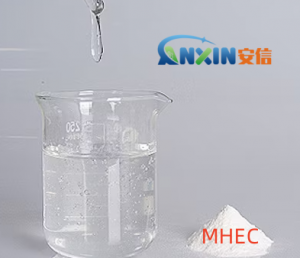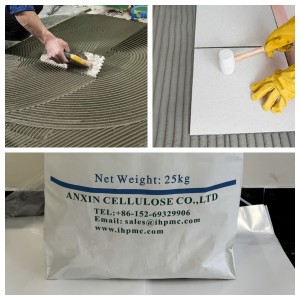Methyl Hydroxyethyl Cellulose (MHEC) is a widely used high-molecular-weight cellulose ether in building materials, possessing excellent thickening, water-retention, stabilizing, and workability-improving properties. As an important organic polymeric additive, MHEC has become an indispensable additive in modern dry-mix mortars, putty powders, tile adhesives, coatings, and insulation systems, and its role and development prospects in the construction industry are becoming increasingly prominent.
1. The Importance of MHEC in the Construction Industry
1.1. Improving Mortar Workability
MHEC can significantly improve the consistency and workability of dry-mix mortars. Its thickening effect allows the mortar to maintain good fluidity and thixotropy during construction, preventing slippage and ensuring uniform spreading of the material on walls or floors. Furthermore, MHEC’s bonding strength enhances the adhesion between the mortar and the substrate, improving construction quality and durability.
1.2. Enhanced Water Retention and Anti-Sagging Properties
Building mortar is prone to cracking or insufficient bonding due to rapid water evaporation during construction. MHEC molecular structure contains hydrophilic groups, which effectively lock in moisture and slow down water loss, thereby improving the mortar’s water retention performance and ensuring sufficient cement hydration. Simultaneously, its excellent anti-sagging properties prevent mortar sagging during vertical construction, improving construction efficiency.
1.3. Improved Material Stability and Construction Adaptability
MHEC can regulate the rheological properties of materials, allowing mortar, putty, or coatings to maintain stable construction performance under different climatic conditions. Especially in high-temperature or dry environments, MHEC maintains good water retention, effectively preventing cracking and hollowing problems, demonstrating strong adaptability.
1.4. Improved Coating System Uniformity and Film-Forming Properties
In water-based architectural coatings, MHEC not only acts as a thickener and stabilizer but also improves pigment dispersibility, resulting in more uniform and fuller paint colors. Its excellent film-forming properties and anti-splatter properties help improve the appearance and durability of coatings, meeting the dual requirements of aesthetics and environmental protection in modern architecture.
2. Technical Advantages of MHEC
2.1. Excellent Solubility and Compatibility
MHEC dissolves rapidly in cold water, forming a transparent, high-viscosity solution. It exhibits excellent compatibility with various inorganic cementitious materials, polymer powders, and pigment systems, offering flexible application and adaptability to a variety of building formulations.
2.2. Stable Chemical Properties
MHEC has strong resistance to acids, alkalis, and salts, and is not easily degraded or degraded, maintaining stable performance in complex chemical environments. This characteristic makes it exhibit excellent durability in cement-based, gypsum-based, or lime-based systems.
2.3. High Environmental Safety
MHEC is a non-ionic cellulose ether derived from natural cellulose. The production process does not contain harmful components, and it has good biodegradability, meeting the environmental requirements of green building and sustainable development.
3. Application Areas of MHEC
Tile adhesives and grouts: Improve adhesion and anti-slip properties, ensuring a smooth finish;
Plastering mortars and thermal insulation mortars: Enhance water retention and crack resistance, improving surface smoothness;
Putty powder: Improve application smoothness, prevent cracking, and increase surface density;
Self-leveling mortars: Adjust flowability and consistency, resulting in a smoother floor finish;
Latex paints and water-based coatings: Improve thickening, dispersing, and rheological properties, enhancing the application feel.
4. Development Prospects of MHEC
4.1. High Performance
The increasing demands for workability and durability in building materials are driving the development of MHEC towards higher substitution rates, higher purity, lower ash content, and precise viscosity control. High-performance MHEC will occupy a larger share in high-end applications such as self-leveling and flexible mortars.
4.2. Environmental Protection and Sustainable Development
In the context of “dual carbon” (carbon dioxide, carbon emissions, and carbon sequestration), building materials emphasize low energy consumption and biodegradability. MHEC, an environmentally friendly additive derived from natural cellulose, is poised to become a preferred material for replacing some synthetic polymers, contributing to the construction of green building systems.
4.3. Customization and Multifunctionality
In the future, MHEC will undergo molecular structure optimization for different application scenarios to achieve specific properties such as fast-dissolving, freeze-thaw resistant, or high water-retention products, meeting the needs of different climates, construction processes, and substrates.
4.4. Internationalization and Domestic Production in Parallel
With the improvement of domestic and international building standards, China’s MHEC industry is developing rapidly. Domestic brands are gradually approaching international levels in terms of quality and stability, and will have stronger competitiveness in the global building materials market in the future.
MHEC, with its excellent physicochemical properties and environmentally friendly characteristics, is becoming an irreplaceable functional additive in the construction industry. With the continuous promotion of green building concepts and new construction techniques, the application scope of MHEC will further expand, and its role in improving the performance of building materials and promoting the upgrading of the construction industry will become increasingly significant, with a very broad future development prospect.
Post time: Nov-01-2025

